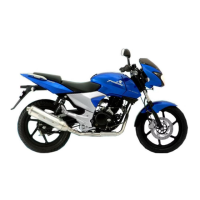Dealer Development Center
46
Dealer Development Center
45
1. Pilot Jet
2. Pilot Outlet Hole
3. Bypass /
Progression Holes
4. Butterfly Valve
5. Volume Control
Screw
6. Throttle Lever
Function
The progression circuit provides the air / fuel mixture at small throttle opening when pilot circuit is still
working but unable to meet the engine demands on small throttle opening.
Construction
The progression circuit follows the path of pilot circuit and the construction is same as that of pilot
circuit.
Working
As like pilot circuit the fuel is metered by pilot jet and air volume is metered by pilot air jet. This mixture
in vaporized / atomized form is discharged through the bypass ports when the butterfly valve is opened
from idling further.
Towards
Engine
Air Inlet
for pilot jet
Progression Circuit : Constant Velocity Carburettor
Pulsar DTS-i UG-III-180cc Training NotesPulsar DTS-i UG-III-180cc Training Notes
Main Circuit : Constant Velocity Carburettor
1. Piston Valve
2. Piston Valve Diaphragm
3. Jet Needle
4. Needle Jet
5. Jet Holder
6. Main Jet
Function
The Main Circuit provides air fuel mixture by
lifting up the piston valve in direct proportion
to the engine demand. This assures the
correct venture size & air velocity throughout
the mid range operation of the engine.
Construction
This circuit consists of jet needle, needle jet
and main jet. To assist in atomization an air
bleed circuit is incorporated in the main
metering system and it aids fuel vaporization
by introducing the air into the fuel before it
enters the main air stream.
Towards
Engine
Air Inlet
for main jet
The piston valve movement is controlled by spring and carburettor venture vacuum which is generated
below the piston valve diaphragm.
Working
When the butterfly valve is opened and air flow through the venturi increases, the air pressure in the
venturi (and the upper chamber) decreases.
As the atmospheric pressure in the bottom chamber is greater than the venturi pressure above the
diaphragm, the piston valve along with jet needle is pushed up and more air fuel mixture is drawn into
the engine from main jet through needle jet into the main air stream.
When the butterfly valve is closed, air flow through the venturi decreases; air pressure in the venturi
increases and approaches atmospheric pressure, & the spring pushes the piston valve along with jet
needle down.
Working of CarburettorWorking of Carburettor

